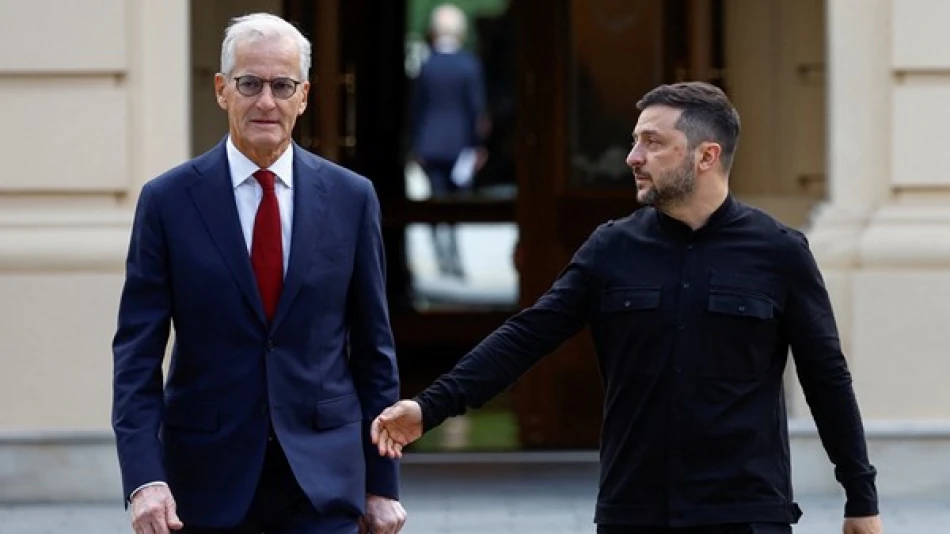
Zelensky Announces High-Level US-Ukraine Meeting This Week
Ukraine Seeks $1 Billion Monthly Arms Deal as Zelensky Prepares for Potential Putin Talks
Ukrainian President Volodymyr Zelensky announced plans to discuss preparations for a potential meeting with Russian President Vladimir Putin, while simultaneously securing at least $1 billion monthly from Western allies specifically for American weapons purchases. The dual-track approach—diplomatic engagement paired with military strengthening—signals Ukraine's strategy to negotiate from a position of enhanced firepower as the conflict enters a critical phase.
High-Stakes Diplomacy Meets Military Procurement
Speaking during a joint briefing in Kyiv with Norwegian Prime Minister Jonas Gahr Støre, Zelensky revealed that Ukrainian and American officials are expected to meet this week to discuss both the potential Putin summit and security guarantees for Ukraine. The discussions will involve Keith Kellogg, the U.S. special envoy, highlighting Washington's central role in any diplomatic breakthrough.
This represents a significant shift from earlier Ukrainian positions that ruled out direct negotiations with Moscow. The timing suggests Ukraine may be positioning itself for talks while the incoming Trump administration signals a desire to resolve the conflict quickly.
The Billion-Dollar Arms Strategy
Zelensky's demand for $1 billion monthly specifically for American weapons purchases reflects a calculated approach to both military needs and alliance management. By earmarking funds for U.S. defense contractors, Ukraine ensures continued American industrial and political investment in its survival while addressing concerns in Washington about the economic benefits of aid packages.
This procurement model mirrors successful defense partnerships between the U.S. and allies like Israel, where military aid directly supports American manufacturing jobs while strengthening the recipient nation's capabilities. For Ukraine, it represents an evolution from emergency assistance to a structured, long-term defense relationship.
Norway Emerges as Ukraine's Financial Backbone
Norway's commitment to provide 85 billion kroner ($7.2 billion) in 2026—matching its 2025 pledge—positions the Nordic nation as one of Ukraine's most reliable supporters. If approved by parliament, Norway's total civilian and military support from 2023 to 2030 will reach 275 billion kroner (over $23 billion).
This sustained commitment is particularly significant given Norway's oil wealth and strategic position as a NATO member bordering Russia. Prime Minister Støre emphasized that Norway could contribute to Ukraine's security guarantees, specifically in air defense and maritime security—areas where Norway's geographic position and military capabilities offer unique value.
Security Guarantees: The Missing Piece
The focus on security guarantees reveals Ukraine's core concern: preventing future Russian aggression even after a potential ceasefire. Unlike NATO's Article 5 collective defense clause, these bilateral or multilateral guarantees would need to be crafted specifically for Ukraine's situation.
Norway's offer to contribute to air defense and maritime security guarantees is strategically important. Norwegian involvement would bring NATO-standard equipment and procedures, while the country's experience defending Arctic territories against Russian probes offers relevant expertise for Ukraine's long-term security architecture.
Market and Strategic Implications
For defense contractors, Ukraine's $1 billion monthly commitment represents a substantial, predictable revenue stream that could justify expanded production capacity. American companies like Lockheed Martin, Raytheon, and General Dynamics stand to benefit from sustained Ukrainian procurement, while European defense firms may find opportunities in Norway's parallel support programs.
The structured approach to military aid also reduces uncertainty for both suppliers and recipients, enabling longer-term planning that emergency assistance packages cannot provide. This shift toward institutionalized support suggests the conflict's transformation from an acute crisis to a managed, long-term security challenge requiring sustained international engagement.
Most Viewed News

 Layla Al Mansoori
Layla Al Mansoori






